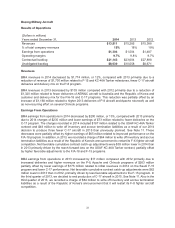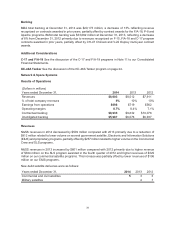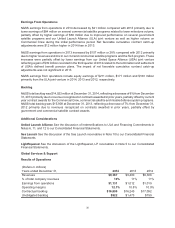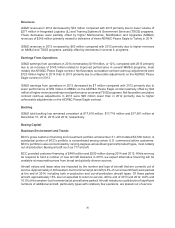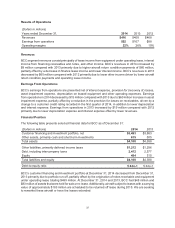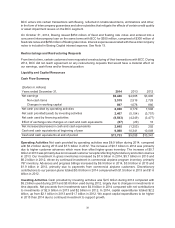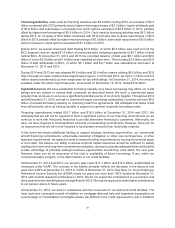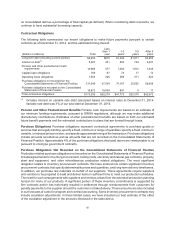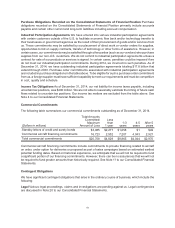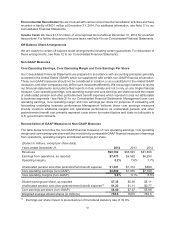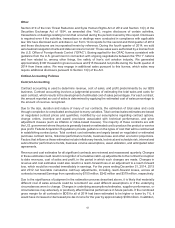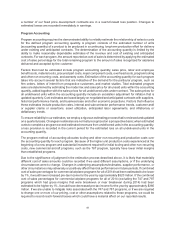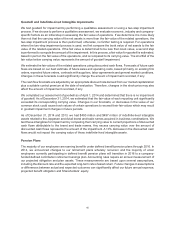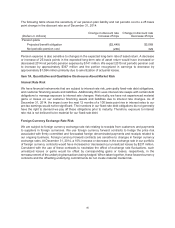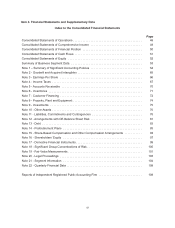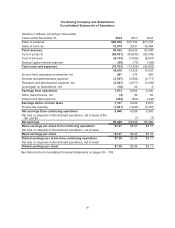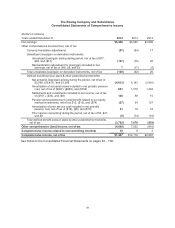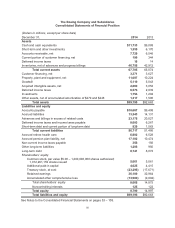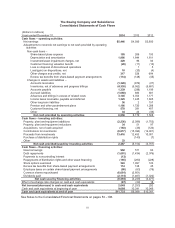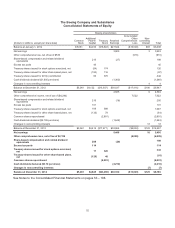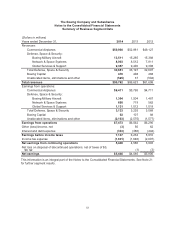Boeing 2014 Annual Report Download - page 55
Download and view the complete annual report
Please find page 55 of the 2014 Boeing annual report below. You can navigate through the pages in the report by either clicking on the pages listed below, or by using the keyword search tool below to find specific information within the annual report.43
Other
Section 219 of the Iran Threat Reduction and Syria Human Rights Act of 2012 and Section 13(r) of the
Securities Exchange Act of 1934, as amended (the “Act”), require disclosure of certain activities,
transactions or dealings relating to Iran that occurred during the period covered by this report. Disclosure
is required even if the activities, transactions or dealings were conducted in compliance with applicable
law. We have disclosed such activities in our Form 10-Q reports for the second and third quarter of 2014
and those disclosures are incorporated herein by reference. During the fourth quarter of 2014, we sold
aeronautical navigation charts and data services to Iran Air. These sales were authorized by a license from
the U.S. Office of Foreign Assets Control (“OFAC”). Boeing applied for the OFAC license consistent with
guidance from the U.S. government in connection with ongoing negotiations between the “P5+1” nations
and Iran related to, among other things, the safety of Iran’s civil aviation industry. We generated
approximately $190 thousand in gross revenues and $15 thousand net profits during the fourth quarter of
2014 from these sales. We may engage in additional sales pursuant to this license, which sales may
require additional disclosure pursuant to Section 13(r) of the Act.
Critical Accounting Policies
Contract Accounting
Contract accounting is used to determine revenue, cost of sales, and profit predominantly by our BDS
business. Contract accounting involves a judgmental process of estimating the total sales and costs for
each contract, which results in the development of estimated cost of sales percentages. For each contract,
the amount reported as cost of sales is determined by applying the estimated cost of sales percentage to
the amount of revenue recognized.
Due to the size, duration and nature of many of our contracts, the estimation of total sales and costs
through completion is complicated and subject to many variables. Total contract sales estimates are based
on negotiated contract prices and quantities, modified by our assumptions regarding contract options,
change orders, incentive and award provisions associated with technical performance, and price
adjustment clauses (such as inflation or index-based clauses). The majority of these contracts are with
the U.S. government where the price is generally based on estimated cost to produce the product or service
plus profit. Federal Acquisition Regulations provide guidance on the types of cost that will be reimbursed
in establishing contract price. Total contract cost estimates are largely based on negotiated or estimated
purchase contract terms, historical performance trends, business base and other economic projections.
Factors that influence these estimates include inflationary trends, technical and schedule risk, internal and
subcontractor performance trends, business volume assumptions, asset utilization, and anticipated labor
agreements.
Revenue and cost estimates for all significant contracts are reviewed and reassessed quarterly. Changes
in these estimates could result in recognition of cumulative catch-up adjustments to the contract’s inception
to date revenues, cost of sales and profit, in the period in which such changes are made. Changes in
revenue and cost estimates could also result in a reach-forward loss or an adjustment to a reach-forward
loss, which would be recorded immediately in earnings. For the years ending December 31, 2014, 2013
and 2012 net favorable cumulative catch-up adjustments, including reach-forward losses, across all
contracts increased Earnings from operations by $100 million, $242 million and $379 million, respectively.
Due to the significance of judgment in the estimation process described above, it is likely that materially
different cost of sales amounts could be recorded if we used different assumptions or if the underlying
circumstances were to change. Changes in underlying assumptions/estimates, supplier performance, or
circumstances may adversely or positively affect financial performance in future periods. If the combined
gross margin for all contracts in BDS for all of 2014 had been estimated to be higher or lower by 1%, it
would have increased or decreased pre-tax income for the year by approximately $309 million. In addition,


